What is reverse ETL and what are the best reverse ETL tools for your business?
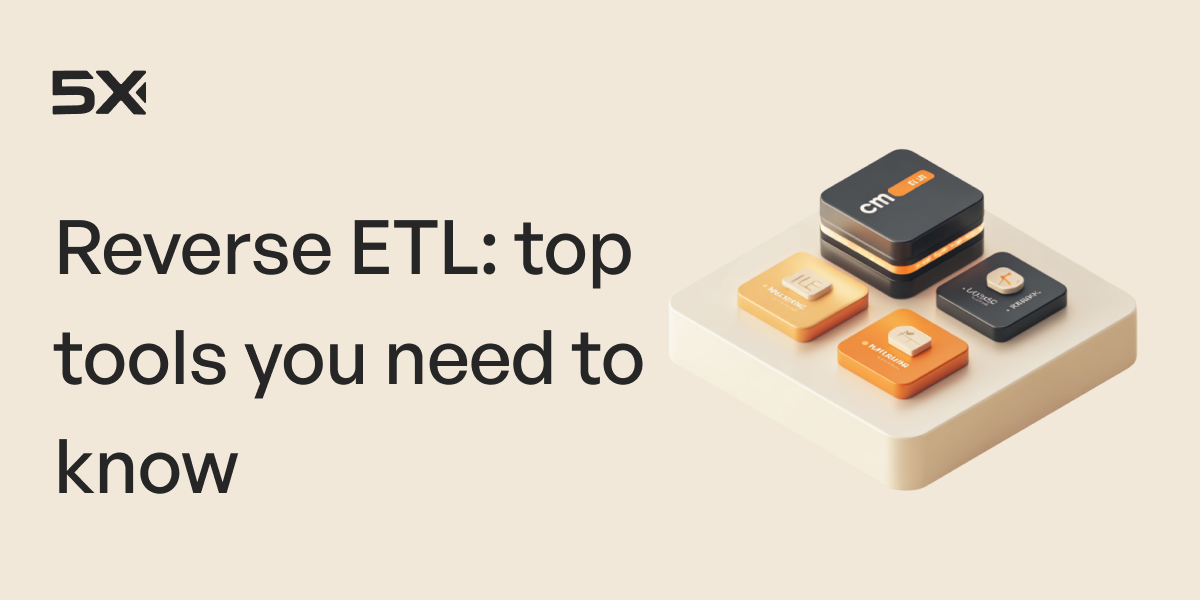
.png)
Table of Contents
TL; DR
- Reverse ETL solves the “last-mile” data problem by sending clean, warehouse data into tools your teams actually use (CRM, marketing, support)
- Key benefits include real-time syncing, unified data, automation, and consistent information across all teams
- Reverse ETL tools save time and reduce silos by automating data movement
- In 2025, Reverse ETL is essential for modern data-driven teams that want to bridge the gap between analytics and execution
- Look for pre-built connectors, transformations, and strong governance when shortlisting a reverse ETL tool for your business
If your company is still investing heavily in data warehouses, dashboards, and analytics teams but your support teams are still making decisions in the dark, the issue isn’t data quality but accessibility.
Reverse ETL solves this last-mile problem by syncing clean, warehouse data into everyday business tools, helping teams act on insights instantly instead of waiting on reports.
In this blog, you’ll learn what reverse ETL is, how it works, why it’s becoming essential for modern businesses, and which tools can help you bridge the gap between analytics and execution.
What is reverse ETL?
Think of Reverse ETL as the final mile of your data journey. It takes clean, analyzed data from your warehouse or lake and pushes it back into everyday tools like your CRM, marketing automation platform, or support system i.e. destinations where teams actually work.
Reverse ETL (Extract, Transform, Load) is a process where data is taken from a centralized data warehouse or data lake and distributed into various operational systems or tools. It is gaining importance in the modern data stack as organizations seek to leverage their data assets more comprehensively, bridging the gap between data analysis and operational applications.
- Sneha Challa, Lead Product Manager, Dr. Reddy’s Laboratories
ETL vs reverse ETL vs ELT: What’s the difference?
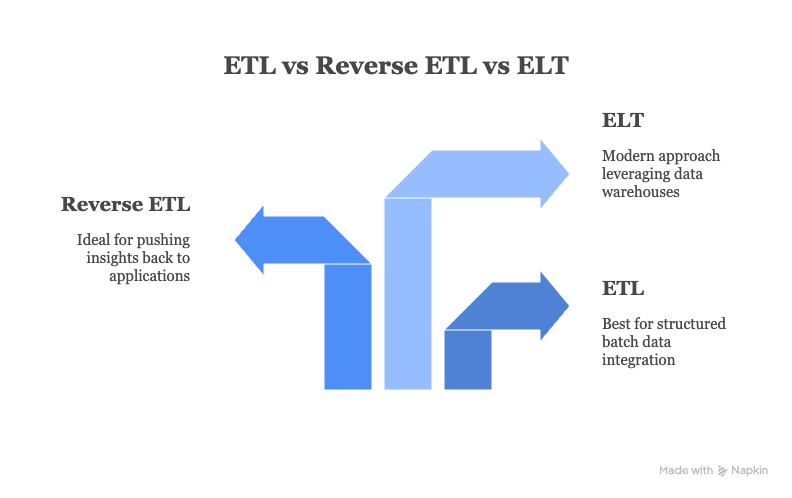
It’s easy to get confused between ETL, ELT, and reverse ETL. They sound similar but serve very different purposes in your data stack. Here’s how they compare:
1. ETL (Extract, Transform, Load)
ETL is the classic data integration process. It extracts data from multiple sources (like CRMs or web apps), transforms it into a clean, consistent format, and then loads it into your data warehouse for analysis. In short, traditional ETL pulls data into a warehouse for analysis.
Goal: Centralize data for reporting and analytics.
2. ELT (Extract, Load, Transform)
ELT flips the middle steps. It extracts data and loads it directly into the warehouse first, then transforms it there using the warehouse’s computing power
Goal: Make transformations faster and more scalable in modern cloud warehouses.
3. Reverse ETL
Reverse ETL does the opposite of ETL. It takes refined data from your warehouse and sends it back into operational tools so your sales team sees updated lead scores, your marketers target the right segments, and your support team gets real-time customer context.
Goal: Put valuable data directly into the hands of sales, marketing, and support teams.
Why should you use reverse ETL tools?
Reverse ETL tools close that last-mile gap between analytics and execution by ensuring that every team, from sales to marketing to support, has the right data where they need it, when they need it.
Instead of manually exporting CSVs or waiting on data teams, reverse ETL tools ensure that your CRM updates in real time, campaigns auto-personalize, and customer success teams can proactively act on churn signals. In short, a reverse ETL software turns your warehouse into a living, breathing system of action where data both informs and powers your strategy.
What are the key features of reverse ETL tools?
The best reverse ETL tools move data while ensuring that it flows smoothly, securely, and usefully between your warehouse and business applications.
When choosing one, here’s what you can look for:
- Effortless, real-time syncing: Your teams shouldn’t be waiting for yesterday’s data. Look for tools that automatically sync in real-time or on a schedule, so insights stay fresh across every system including your CRM and marketing dashboards.
- Pre-built integrations that just work: No one wants to spend weeks wiring things together. The right Reverse ETL software comes with native connectors for popular apps, databases, and cloud platforms, so you can plug into your stack with minimal setup
- Smart data transformations: Before sending data back, your tool should let you clean, map, or format it for compatibility. This ensures your platform gets exactly the data it needs
- Strong access control: When sensitive data is on the move, security can’t be an afterthought. Role-based permissions (RBAC) ensure only the right people can make changes or access specific datasets, and gives access to the right people in the team
- Built-in monitoring and alerts: Sync failures happen often but they shouldn’t catch you by surprise. Good reverse ETL tools include monitoring, logging, and error alerts, so your team can fix issues before they snowball
- Scalable and fast: As your data grows, your reverse ETL solution should scale with it and handle large transfers, maintain performance, and ensure your workflows never slow down
Benefits of using reverse ETL tools
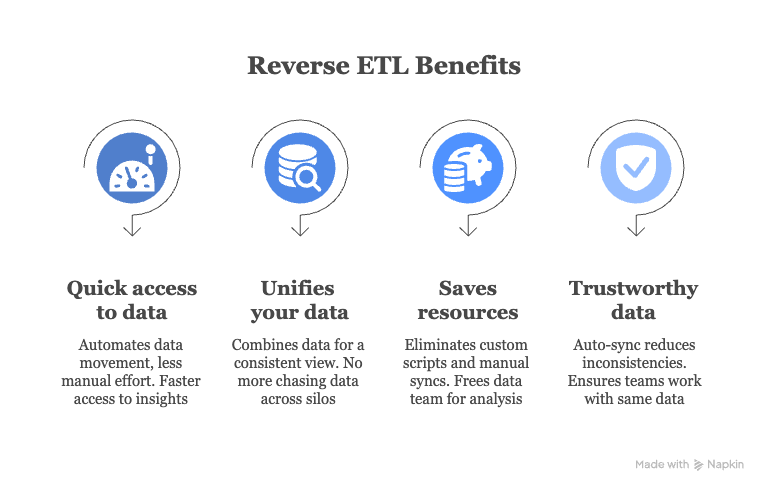
A reverse ETL tool moves data and makes it useful. It makes your warehouse actually work for your business. Instead of keeping insights locked inside dashboards, reverse ETL platforms send that data back into your everyday tools such as your CRM, marketing automation tool, and support platform, so that everyone’s always working with the latest, most reliable information.
Here’s how it helps:
- Faster, cleaner data transformations: Automates how data moves and reshapes across systems. That means less manual effort, fewer errors, and faster access to insights
- Unified, actionable data: By combining datasets from different sources, these tools give you a single, consistent view of your customers, campaigns, and operations. This means there is no more chasing data across silos
- Saves time and money: Reverse ETL eliminates the need for custom scripts or manual syncs, freeing your data team to focus on analysis and innovation instead of maintenance
- Consistent, trustworthy data everywhere: With automatic synchronization between your warehouse and business tools, you reduce inconsistencies and ensure every team from marketing to finance works with the same version of truth
Top reverse ETL Tools in 2025
Here are the top reverse ETL tools you can use in 2025:
Integrate.IO

Integrate.io is a low-code, no-code Reverse ETL platform that makes data movement effortless. Its drag-and-drop interface and pre-built connectors let teams build pipelines in minutes. It also supports ETL, ELT, CDC, and even API generation, making it a flexible all-in-one data integration tool.
Pros:
- Handle complex transformations mid-flight without coding
- Usage-based pricing makes it cost-efficient
- Supports multiple file formats (CSV, XML, JSON, etc.)
- Intuitive UI saves time building and managing pipelines
- Works across ETL, Reverse ETL, and more
Cons:
- ETL job error logs can be hard to interpret
- Limited customization for experienced coders
G2 Rating: 4.3/5
Hightouch
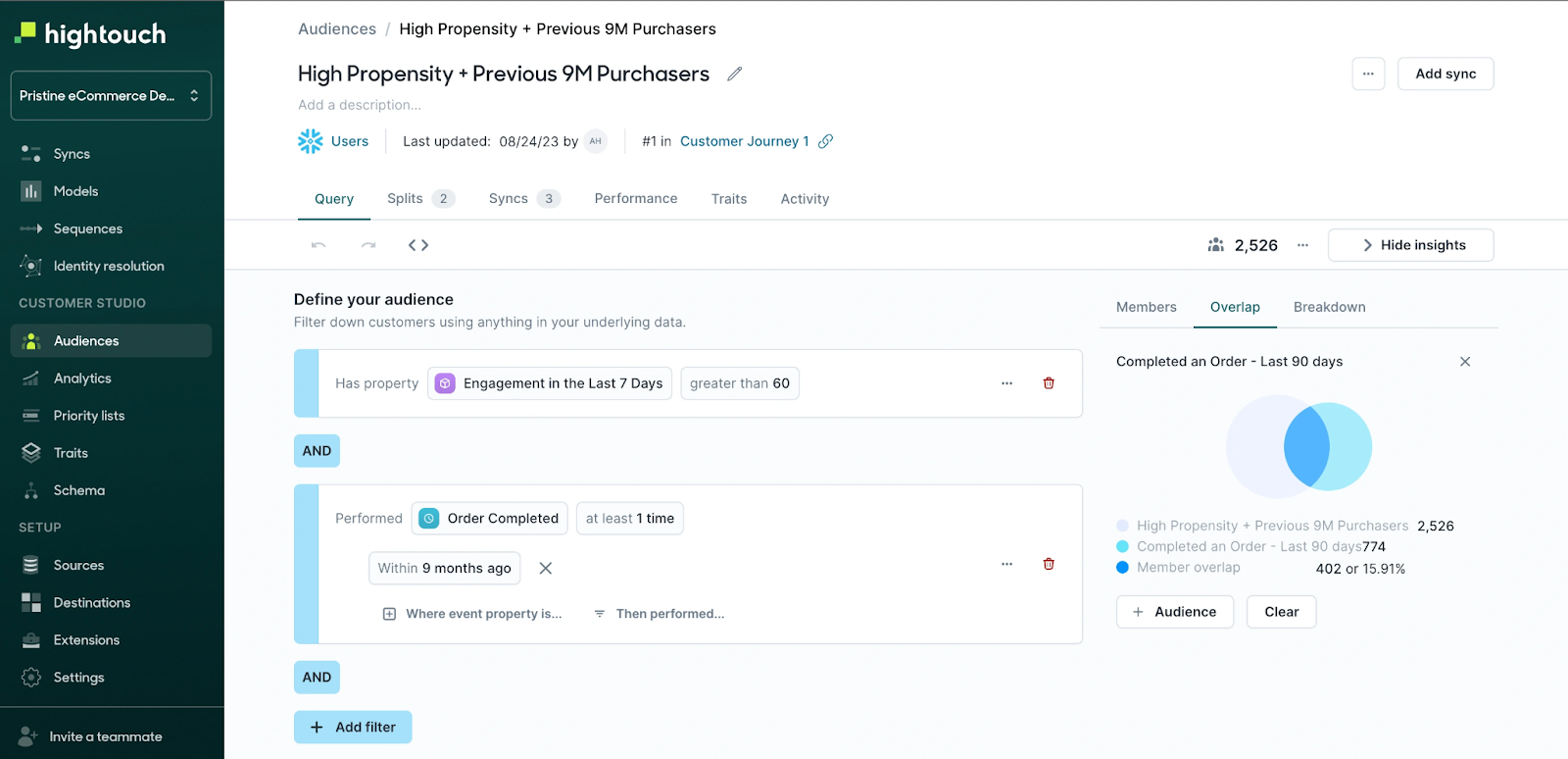
Hightouch is a popular Reverse ETL tool, built for teams that want to activate data directly from their warehouse into CRMs, marketing platforms, and other SaaS tools. It syncs seamlessly with DBT and Git, automating pipeline building once your models are ready. While it offers powerful automation and governance features, it does require some SQL know-how when starting out.
Pros:
- Role-based access control (RBAC) and audit logs for security
- Built-in change management to prevent accidental updates
- Test environment for safe syncs before production
- Automatically writes sync metadata back to your warehouse
Cons:
- Requires SQL knowledge for setup
- Configuration changes can impact data consistency
- Limited historical diff tracking
- Free tier restricted to one destination
G2 Rating: 4.6/5
5X
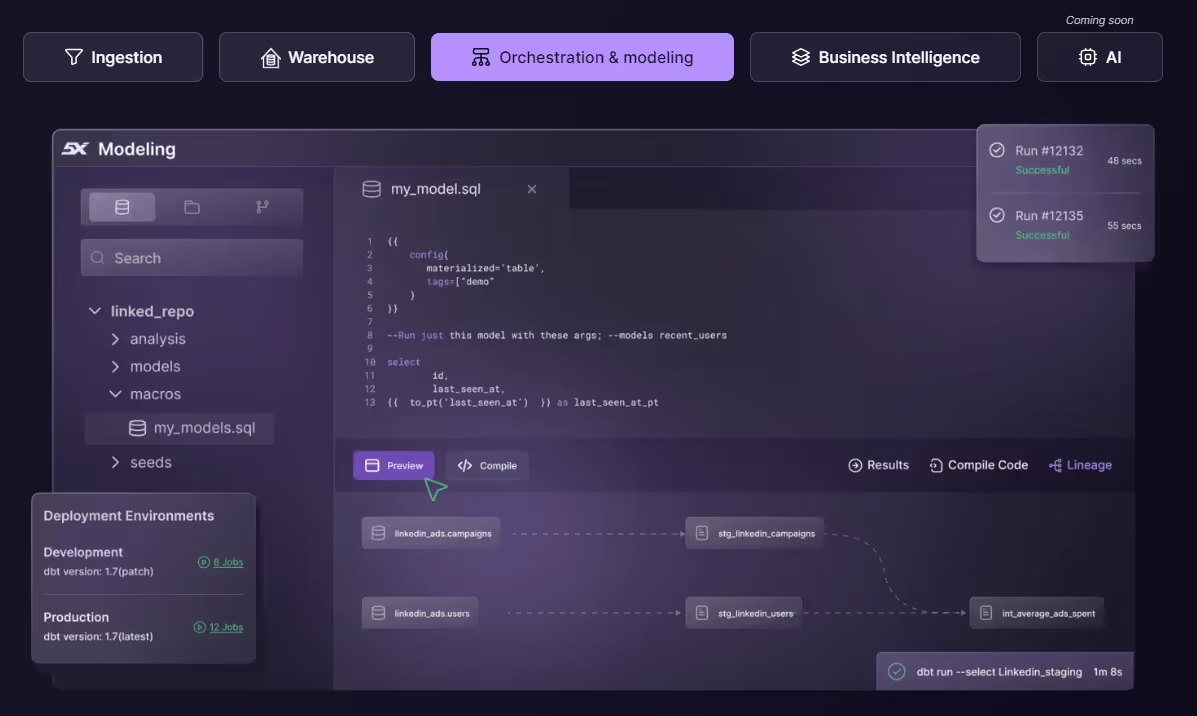
5X is a reverse ETL tool and a full-stack modern data platform built for scalability and speed. Built for teams tired of stitching together fragmented tools, 5X combines ingestion, transformation, governance, observability, and activation into a single, scalable ecosystem.
Instead of managing separate tools for every stage of your data journey, 5X gives you a unique foundation that’s built for performance, compliance, and AI readiness. It is the ideal choice for teams that want scalability and integrated governance rather than just point-to-point syncing.
Pros:
- 500+ pre-built data connectors
- Real-time syncing and scalable pipelines for AI and analytics workloads
- Built-in governance, RBAC, and compliance-ready infrastructure
- Pre-integrated ecosystem of best-in-class data tools
- End-to-end data platform offering reverse ETL, ingestion, transformation, governance, and observability in one
Cons:
- Requires SQL knowledge for setup
- Configuration changes can impact data consistency
- Limited historical diff tracking
- Free tier restricted to one destination
G2 Rating: 4.9/5
How to choose the right reverse ETL tool?
Choosing good reverse ETL platforms is all about finding the right fit for your team, your data stack, and your business goals. Here’s how to make a smart pick:
- Start with your needs: Before jumping into demos, talk to your data engineers, marketing, sales ops, and others who actually use the tool. What problems do they want to solve? What data do they need flowing back into their tools? Aligning on this early saves time and effort
- Factor in your budget: Not every company needs an enterprise-grade solution right away. If your data volumes are small, you can start with lighter or even open-source tools. But if you’re scaling fast or already managing huge datasets and have the budget for more expensive tools that offer more functionality, invest in something that grows with you
- Match it to your data workflows: Got complex pipelines or multiple data sources? You’ll need a tool built to handle that complexity. The best reverse ETL platforms adapt to your existing workflows, not the other way around
- Check the integrations: Your reverse ETL tool should connect easily with your daily-use systems such as Salesforce, HubSpot, Slack, Snowflake, and so on. Look for platforms with pre-built connectors for your tech stack so you’re not stuck writing custom scripts
- Don’t compromise on security: When data is moving between systems, compliance and access control matter. Make sure your tool supports encryption, RBAC, and adheres to regulations like GDPR or SOC 2
- Look for strong monitoring and alerts: You don’t want to find out about sync failures from your sales team at a later stage. Choose tools with dashboards, logs, and automated alerts to flag issues early and keep pipelines healthy
- Ease of use and support matter more than you think: Go for intuitive interfaces, simple onboarding, and responsive customer support that actually helps when things break. If you want more from your reverse ETL tool than just point-to-point syncing, 5X is an ideal choice as it enables you to scale while offering integrated governance
FAQs
What is a Reverse ETL platform? What does it actually do?

What is reverse ETL vs ETL? How is Reverse ETL different from traditional ETL?

Why should my business use Reverse ETL tools?

What are the main benefits of Reverse ETL?

Building a data platform doesn’t have to be hectic. Spending over four months and 20% dev time just to set up your data platform is ridiculous. Make 5X your data partner with faster setups, lower upfront costs, and 0% dev time. Let your data engineering team focus on actioning insights, not building infrastructure ;)
Book a free consultationHere are some next steps you can take:
- Want to see it in action? Request a free demo.
- Want more guidance on using Preset via 5X? Explore our Help Docs.
- Ready to consolidate your data pipeline? Chat with us now.
Get notified when a new article is released
Sync smarter. Scale faster with 5X.
Sync smarter. Scale faster with 5X.

How retail leaders unlock hidden profits and 10% margins
Retailers are sitting on untapped profit opportunities—through pricing, inventory, and procurement. Find out how to uncover these hidden gains in our free webinar.
Save your spot





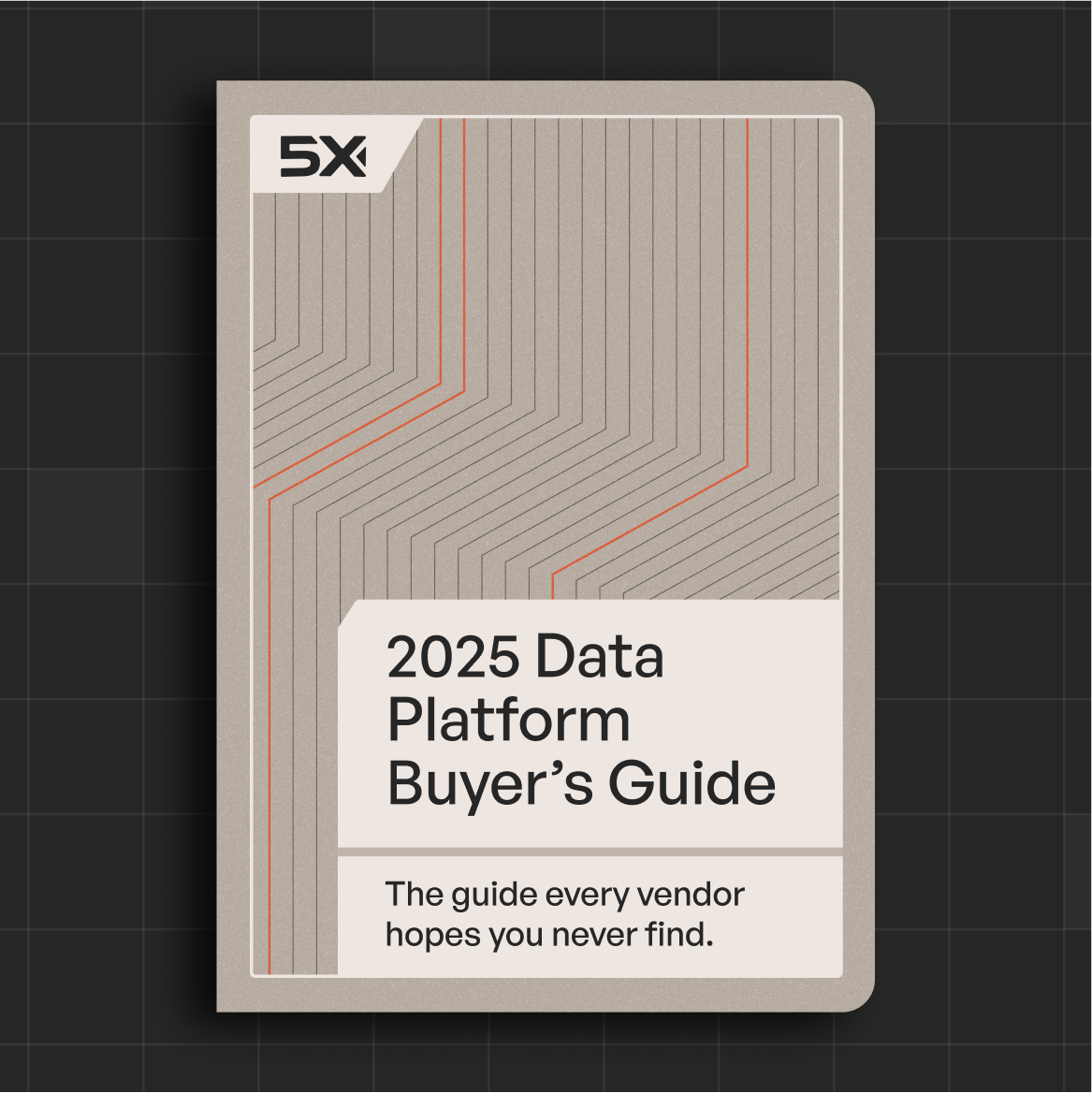

%201.svg)
.png)
.png)
.png)






